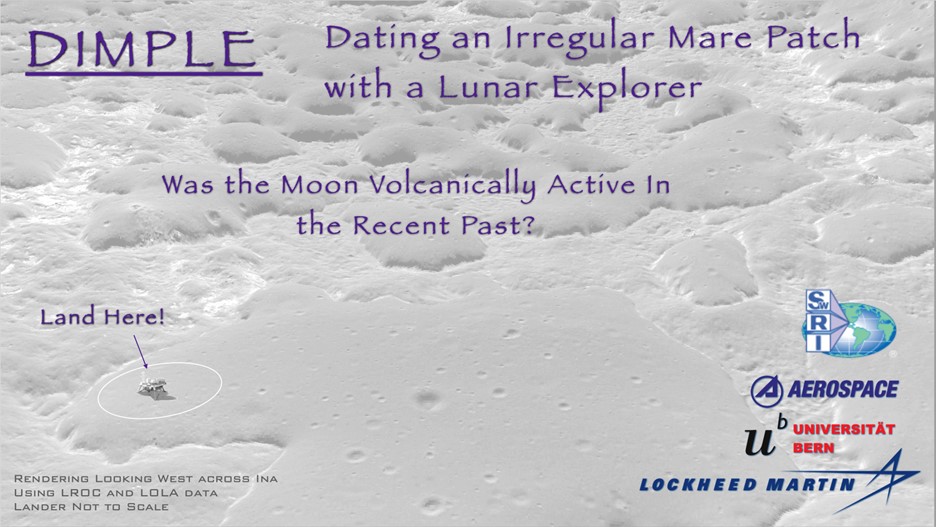May 31st Observatory Open House / Lecture /Public Star Night
DIMPLE:
An Experiment to Determine if the Moon was Volcanically Active in the Geologically Recent Past
Is the subject of this month’s Estes Valley Astronomical Society (EVAS) meeting. EVAS, in conjunction with the Estes Park Memorial Observatory, is offering a free public lecture on Saturday, May 31, 2025, at the Estes Park Memorial Observatory. The goal of EVAS is to promote amateur astronomy and education in the Estes Valley.
The ground-breaking DIMPLE (Dating an Irregular Mare Patch with a Lunar Explorer) experiment will for the first time send a rock-dating instrument to resolve a scientific mystery on the Moon. The objective of DIMPLE is to date rocks from within the 3×2 km volcanic caldera of a shield volcano called Ina. The rough interior of Ina, referred to as an irregular mare patch, is remarkable for its scarcity of craters from meteoroid impacts. Taken at face value, the relatively low density of craters implies a surface age of 33 ± 2 million years. If the Moon was volcanically active this recently, it would require a profound reassessment of our understanding of how small planets like the Moon retain heat over the eons. By comparison, the youngest volcanic rocks from the Moon that have yet been experimentally dated are 2000 million years old. An alternative explanation for the anomalously low crater density posits that Ina is a chilled magmatic foam, the vesicularity of which favors crumbling rather than cratering during meteoroid impacts. If vesicularity can make a ~3700 million year old landform appear to be a hundred times younger, it begs the question of what other age estimates based on crater density of planetary surfaces, from anywhere in the inner Solar System, can also be wildly inaccurate. DIMPLE was selected by NASA for a flight to the Moon in 2028.
The DIMPLE payload includes (i) the CODEX (Chemistry, Organics, and Dating Experiment) instrument, (ii) a sample-handling system including an arm for gripping rocks from the lunar surface, and (iii) a rover-mounted rake for collecting rock samples from farther afield. CODEX works by analyzing hundreds of tiny spots over rock samples about an inch across, using two different laser-based techniques to measure the abundances of many elements and rubidium and strontium isotopes. CODEX data will enable dating by determining how much strontium has accumulated from radioactive decay of rubidium and, by mapping elemental composition, will permit the identification and interpretation of the rock types sampled at Ina.
Our guest speaker for this public star night will be Dr. F. Scott Anderson. He is the Principle Investigator of DIMPLE. He will share the story of the development of the CODEX dating technique, the science to be accomplished at Ina, and the pathway to flight in 2028. Scott  has been a strong proponent of the decade-long effort to make in-situ chronology measurements a reality. He has developed three prototype dating instruments and is an expert in laser processes, laser development, and resonance ionization, in addition to having built multiple mass spectrometers. His research portfolio includes science investigations in the areas of geochronology, geophysical/tectonic formation of Valles Marineris (Mars), heat flow and gravity studies of Venus, and the discovery of chlorides on Mars via thermal infrared spectroscopy. He has worked with data from Mars missions and has won awards for excellence from NASA.
has been a strong proponent of the decade-long effort to make in-situ chronology measurements a reality. He has developed three prototype dating instruments and is an expert in laser processes, laser development, and resonance ionization, in addition to having built multiple mass spectrometers. His research portfolio includes science investigations in the areas of geochronology, geophysical/tectonic formation of Valles Marineris (Mars), heat flow and gravity studies of Venus, and the discovery of chlorides on Mars via thermal infrared spectroscopy. He has worked with data from Mars missions and has won awards for excellence from NASA.
The observatory is just north of the high school at 1600 Manford Ave. Park in the teacher’s parking lot between the high school and the observatory. The doors will open at 7:00 pm and the meeting will start at 7:30 pm. The presentation, including a question and answer period, lasts about an hour. After the presentation, weather permitting, we will look through our 16-inch dome telescope at various celestial objects.

